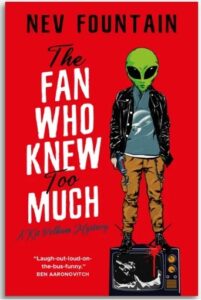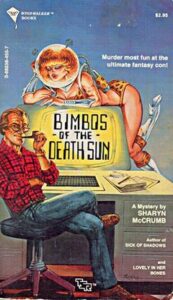Santa has been very kind to me again this year. You may recall that in recent years she’s been kind enough to gift me lavish CD soundtracks for the likes of The Invaders (1967-1968), Voyage to the Botton of the Sea (1964-1968) and The Time Tunnel (1966-1967) and also highly specialist books such as Blake’s 7 Production Diary: Series A (2023… the book that is, the series that we’re talking about is actually 1978-1981).
And this year she gave me the paperback The Fan Who Knew Too Much by Nev Fountain (Titan: 2024).

Fig. 1: Oooooohhh… it’s good. It’s very good.
Basically, it’s a black comedy murder mystery. A traditional one where you don’t have to solve logic puzzles or determine five letter words or anything. You know – a solid, engaging narrative where the clues are there for you to pick up on as well (should you be so inclined). And it’s the first in a new range collectively branded as ‘A Kit Pelham Mystery’, a range that I’m very much looking forward to enjoying the rest of.
Kit Pelham is a devotee of Vixens from the Void (1986-1993), a BBC science-fiction series that – in our universe – never existed. But from an alternative dimension edition of the Into the Void fanzine, we open with a programme guide entry on the show’s debut instalment, Coronation; this catalogues the basic data such as production and transmission dates, cast, crew, synopsis and the creation of the show – describing it as ‘Dallas (1978-1991) meets Dynasty (1981-1989)… but in space’. Only without those bracketed dates which I’ve only inserted ’cus I’m writing for CSTonline and I know how much you guys love your bracketed dates.
One quickly builds up a stylized image of Vixens from the Void from the scraps of information offered in the narrative and the dialogue. Being BBC science-fiction of the pre-CGI age, we kind of know that – had it existed – it would have had the frugal look of the Corporation’s much-loved space opera Blake’s 7, and while it’s trading off the high-camp character machinations of the US primetime soaps referred to above, buried in it were most likely some solid life lessons and social commentary of the sort that the producers of Star Trek (1966-1969) and Star Trek: The Next Generation (1987-1994) successfully smuggled in amidst the aliens and spaceships with varying degrees of subtlety.
Anyway, Kit has done all the fanzine and fandom bit, and has now arrived in one of those roles that has become A Thing since about the 1990s: the professional fan. She interviews the cast and crew of her favourite show, works on highly specialist documentaries destined to become Value Added Material on yet another physical media release, and uses her knowledge and connections to the show and those who made it to offer worthwhile pieces of prose to a variety of publications. And – as we like to have with most of our heroes these days – she also comes complete with her own set of issues over which she aims to triumph… while simultaneously discovering who murdered her podcasting friend moments before he was about to make a major revelation about Vixens from the Void.
The 2022 murder is somehow linked to an unexplained death that occurred during a location shoot for Vixens from the Void back in 1987. So, to solve the present day killing, Kit really needs to understand what really happened on the set of her favourite show some 35 years earlier. And we all know that the best way to do that is to get finance for a Blu-ray extra reunion featurette that brings all the original suspects back to the scene of the crime…
What unfolds is an extremely good murder mystery that takes some deeply unexpected turns while embracing a range of ingredients: the shift in cultural norms across the decades, the cost-conscious production techniques of period television programming, the methods of historical and contextual research, etc. There’s also the theft of a very unexpected item along the way, and some superbly planted clues which will allow the astute reader to realise–SPOILER (I’m not going to give away any of these treats in some tatty spoiler section).

Fig. 2: Thanks again Hilary!
But – most of all – it’s about the fan base. And all the different ways in which different people who came to the series in different ways relate to the same programme – in some cases, murderously so – and how they are all looking for slightly different things from it to fill various sized gaps in their lives.
Of course, the SF fan satire is nothing new. Around the time that Vixens from the Void was airing in a dimension three to the left from our own, my dear friend Hilary – whose rich contribution to my life I have celebrated previously – gifted me a copy of Bimbos of the Death Sun (1987), a superbly enjoyable murder mystery by Sharyn McCrumb set at a science-fiction convention in Washington which plunged an electrical engineer (whose hard science hypotheses had accidentally become a cult SF novel when published under a deliberately trashy title) into a homicide whodunnit populated by familiar tropes of fandom. Check it out if you get chance – it made me smile at the time and still does. There’s also a sequel: Zombies of the Gene Pool (1992).
Indeed, Nev Fountain originally developed Vixens from the Void as the linking theme of an earlier trilogy of comedy thrillers known as ‘The Mervyn Stone Mysteries’. The main protagonist here had been Mervyn Stone, co-creator, lead writer and script editor to the defunct cult series whose understanding of people made him an ideal sleuth when murder struck at a convention celebrating the show, during a DVD commentary recording, and when his creation was destined for a 21st Century reboot to put Cornwall on the TV production map in the same way that Doctor Who (1963-can’tbebothered) had done for Cardiff. There was also a rather clever audio drama spin-off which used the structure of an audio drama to fool you into thinking that you were listening to an audio drama when really you were listening to an audio drama. Very smart!

Fig. 3: The one with the poisoning in the DVD commentary booth is particularly good.
While Mervyn Stone was most enjoyable to spend time with – Kit Pelham is even more so. Because while Mervyn was on the fringes of the sub-culture, Kit’s been in the thick of it, navigating her way through all its different forms until she is in a position in life that’s right for her. And – along the way – collecting a wide range of acquaintances whose relationship to the high-glam hokum of past decades is often very different to her own.
And as I was accompanying Kit through the thrills and spills of documentary making in Brighton, I kept thinking back some three decades to when I read Science Fiction Audiences: Watching Star Trek and Doctor Who (Routledge: 1995), understanding more about fandom while also keeping a dictionary by my side to understand some of the trickier words of three syllables or more.
With The Fan Who Knew Too Much, I didn’t need a dictionary. Nev Fountain was – in so many ways for me – doing what John Tulloch and Henry Jenkins had done, but with at least two deaths, some super gags (as you’d expect from one of the writers of Dead Ringers (2000-2007, 2014-)), a rather lovely history lesson from Dr Alexandra Loske of the University of Sussex, some incisive comments about the wider changes in society, a terrific life-and-death situation aboard a boat, and that very unexpected thing that gets stolen–SPOILER (that I’m still not going to tell you about). And it’s all very exciting.
And one of the loveliest things of all is that as we learn more about Kit and her diverse set of chums, we can be reminded of that passion for some element of television which has latched onto us at a key moment in our lives. And has ended up shaping that life to some extent – researching, understanding, solving mysteries (although possibly not as graphic or fatal as those encountered by Kit), making like-minded friends and skirting the shores of dangerous obsession.
After all – if television hadn’t grabbed you with that kind of interest to understand it and its audiences at some point, you wouldn’t be reading CSTonline now, would you? Most likely in your own capacity as a variation on the ‘professional fan’ that Kit herself has become.
Thanks Santa!
________________________________________________________________________________
Andrew Pixley is a retired data developer. For the last 30 years he’s written about almost anything to do with television if people will pay him – and occasionally when they won’t. His current ringtone is Top Dog by Ivor Slaney from a 1961 De Wolfe production music disc (DW 2681). So, altogether now… “It’s time to meet…” (answers below in the comments section please).





Dear Mr Pixley
Do you know how to get in touch with Pee Jay Hammond.
I’m guessing you might. because you wrote the booklet for the
Ace Of Wands DVD.
As you know, his most personal project was Sapphire and Steel.
I’ve thought of a neat way of extracting Sapphire and Steel from
the trap they got into, at the end of the last adventure, and I think
I could suggest a further story line involving the two main characters
in that story – the two with the Rolls Royce.
TV Land doesn’t seem to be interested in Sapphire and Steel anymore,
but I don’t see any reason why the fanbase couldn’t crowd-fund a reboot,
in the same way that the people who produced the Borley Rectory film
were able to raise the finance for their film
Regards, Jon
Hello Jon 🙂
Sorry – no idea how you’d contact PJ Hammond. I’m afraid that much that I enjoy “Sapphire & Steel”, it’s not a series that I’ve ever really had the chance to research.
Big Finish produced new adventures for the series on audio some years ago; they would probably be the best people to contact.
Alternatively, Richard Callaghan did a rather good book on the series for Telos. You could possibly contact them.
But this is all rights and creative issue which – I’m afraid – isn’t my area at all.
Good luck with it though. 🙂
All the best
Andrew